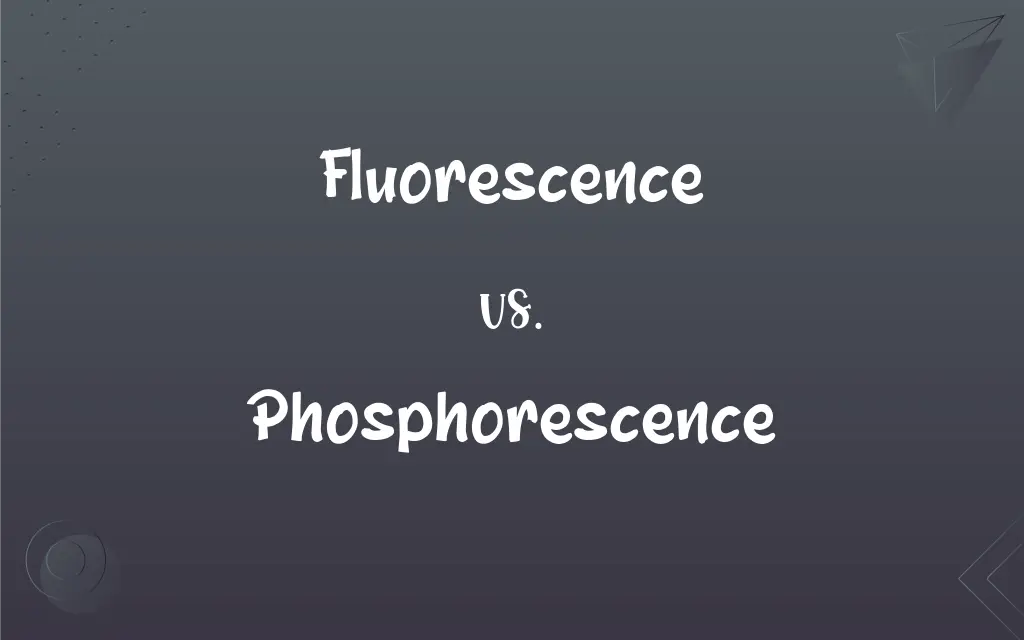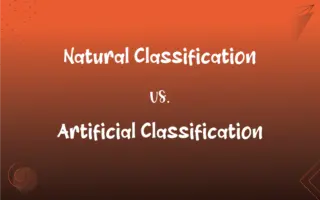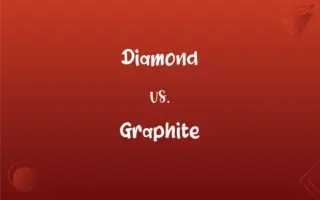Fluorescence vs. Phosphorescence: What's the Difference?
Edited by Janet White || By Harlon Moss || Updated on October 17, 2023
Fluorescence is the immediate emission of light after absorption, while phosphorescence is the delayed emission, lasting longer.

Key Differences
Fluorescence refers to the process where certain materials absorb light and then instantly re-emit it. Phosphorescence, on the other hand, also involves the absorption of light, but the re-emission occurs over a prolonged period.
In fluorescence, the re-emission of light happens almost instantly after the absorption. This is because the electrons return to their ground state rapidly. In phosphorescence, electrons are trapped in an excited state, leading to a delayed emission.
The duration of light emission differentiates the two. Fluorescence ends as soon as the source of light is removed, making it short-lived. Phosphorescence can last from a few seconds to several hours after the light source is gone.
Both fluorescence and phosphorescence are types of photoluminescence. However, the difference in electron behavior during these processes distinguishes them. In fluorescence, the electron's transition is spin-allowed, while in phosphorescence, it's spin-forbidden.
Everyday examples include glow-in-the-dark toys, which exhibit phosphorescence, and fluorescent markers that show fluorescence when exposed to UV light.
ADVERTISEMENT
Comparison Chart
Duration
Immediate emission
Delayed emission, can last longer
Electron Behavior
Spin-allowed transitions
Spin-forbidden transitions
Dependency
Ends once the light source is removed
Can persist even after the light source is gone
Common Usage
Fluorescent lights, markers
Glow-in-the-dark toys, clock hands
Cause
Rapid return to electron ground state
Electrons trapped in an excited state
ADVERTISEMENT
Fluorescence and Phosphorescence Definitions
Fluorescence
A process where absorbed radiation is re-emitted at a different, usually longer, wavelength.
The shirt's fluorescence was evident when it glowed in different colors.
Phosphorescence
The delayed emission of light due to trapped electrons in an excited state.
Certain deep-sea creatures rely on phosphorescence for illumination in the dark waters.
Fluorescence
The immediate emission of light following the absorption of short-wavelength radiation.
The neon colors showed brilliant fluorescence under the blacklight.
Phosphorescence
A type of luminescence where material emits light for an extended period after exposure to radiation.
The stars on my ceiling show phosphorescence, glowing long after the lights are off.
Fluorescence
The optical phenomenon where material emits light in response to radiation.
Researchers use fluorescence microscopy to study biological samples.
Phosphorescence
A glow that persists even after the removal of the stimulating energy source.
The watch hands displayed phosphorescence, allowing me to read the time in complete darkness.
Fluorescence
A form of luminescence where light is emitted for a very short duration.
Many minerals exhibit fluorescence when observed under UV light.
Phosphorescence
The long-lasting counterpart of fluorescence.
Glow-in-the-dark stickers use phosphorescence to maintain their glow.
Fluorescence
A photophysical process that's rapid and short-lived.
The fluorescence of certain dyes helps in scientific imaging.
Phosphorescence
An optical phenomenon resulting from electron transitions that are spin-forbidden.
The eerie glow of the material was due to its phosphorescence, captivating the viewers.
Fluorescence
The emission of electromagnetic radiation, especially of visible light, stimulated in a substance by the absorption of incident radiation and persisting only as long as the stimulating radiation is continued.
Phosphorescence
Persistent emission of light following exposure to and removal of incident radiation.
Fluorescence
The property of emitting such radiation.
Phosphorescence
Emission of light without appreciable heat, as from chemiluminescence of phosphorus or bioluminescence of living organisms.
Phosphorescence
The emission of light without any perceptible heat; the quality of being phosphorescent.
Phosphorescence
The quality or state of being phosphorescent; or the act of phosphorescing.
Phosphorescence
A phosphoric light.
Phosphorescence
A fluorescence that persists after the bombarding radiation has ceased
FAQs
Are fluorescence and phosphorescence both types of luminescence?
Yes, both are forms of photoluminescence, differentiated by their duration and electron behavior.
How can phosphorescence last for hours?
In phosphorescence, electrons get trapped in an excited state, causing a prolonged emission.
Can phosphorescence be seen in daily life?
Yes, common items like glow-in-the-dark toys and clock hands exhibit phosphorescence.
Do all materials exhibit fluorescence or phosphorescence?
No, only certain materials have the ability to fluoresce or phosphoresce.
Why is phosphorescence called "glow-in-the-dark"?
Because phosphorescent materials continue to glow even after the activating light source is removed.
Why do some substances show phosphorescence and not fluorescence?
It depends on the molecular and atomic structure of the substance, which dictates how electrons behave post-absorption.
How is fluorescence used in biology?
Fluorescence is widely used in microscopy to label and visualize biological structures and molecules.
How does temperature affect phosphorescence?
Typically, phosphorescence increases with decreasing temperature, as molecular motion slows down.
Can we control the duration of fluorescence?
The inherent properties of a material dictate fluorescence duration, but environmental factors like temperature can influence it.
Is phosphorescence common in deep-sea creatures?
Yes, many deep-sea creatures use phosphorescence as a source of light in the dark depths of the ocean.
What is fluorescence?
Fluorescence is the immediate emission of light by a substance after absorbing short-wavelength radiation.
How does phosphorescence differ from fluorescence?
Phosphorescence is the delayed emission of light, persisting longer than fluorescence.
Why is fluorescence short-lived?
Because the electrons in fluorescence rapidly return to their ground state after excitation.
Can fluorescence be seen in nature?
Yes, certain marine organisms and minerals naturally exhibit fluorescence.
Can humans exhibit phosphorescence?
No, humans do not naturally exhibit phosphorescence.
Can both phenomena be used in scientific applications?
Yes, both fluorescence and phosphorescence have applications, like in microscopy and material studies.
Are there dangers associated with phosphorescent materials?
Most phosphorescent materials are safe, but it depends on the specific compounds used.
Are black lights related to fluorescence?
Yes, black lights emit UV radiation, which can induce fluorescence in certain materials.
Are fluorescent lights related to fluorescence?
Yes, fluorescent lights work based on the principle of fluorescence, emitting light when exposed to UV radiation.
Is fluorescence always visible to the human eye?
Not always. Fluorescence can occur outside the visible spectrum, but it's often seen when substances are exposed to UV light.
About Author
Written by
Harlon MossHarlon is a seasoned quality moderator and accomplished content writer for Difference Wiki. An alumnus of the prestigious University of California, he earned his degree in Computer Science. Leveraging his academic background, Harlon brings a meticulous and informed perspective to his work, ensuring content accuracy and excellence.
Edited by
Janet WhiteJanet White has been an esteemed writer and blogger for Difference Wiki. Holding a Master's degree in Science and Medical Journalism from the prestigious Boston University, she has consistently demonstrated her expertise and passion for her field. When she's not immersed in her work, Janet relishes her time exercising, delving into a good book, and cherishing moments with friends and family.
































































